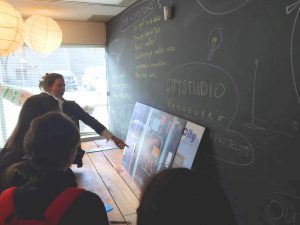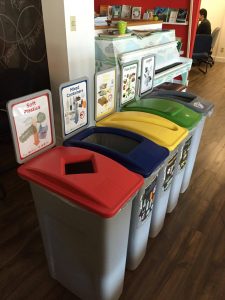“Always have a plan, and believe in it. Nothing happens by accident” – Chuck Knox
Project Proposal
- Here is our Project Proposal (Press the zero-waste station picture below to see the proposal)
Progress
Objectives for this Week:
- Meet with community partners to pick up the new decals, ask about proper application of the decals, discuss our project progress and the upcoming Hubbub event that we’ll be participating in. We will also obtain clarity about specific waste types that we found to confuse people in the first visit and determine proper recycling of them. We hope to gain some clarity regarding project objectives (making sure we are on the right track), important dates (when we should be done by), and our final project for Hubbub.
- Discuss first data collection visit findings as a group. This will allow us to determine what worked, what didn’t work, and how we should alter our data collection techniques in subsequent visits.
- Plan for the next data collection (who’s going, what time, what kind of data to obtain).
- Start thinking about poster ideas for Hubbub event at City Hall on Dec. 2nd. Consider combining data and creating a presentation with the other group.
- Group check-in regarding project timeline, important dates, and future objectives: future site visits, blog postings, assignments, final projects.
Achievements:

So far, we have met with our community partners twice, completed one of three site visits, and completed two group blog postings. We have discussed our future objectives, and planned our second site visit for Friday, Oct 14th.
By having regular meetings with our community partners, we have been able to stay on track with our project, and have formal group check ins, not only with our group, but the other LFS group doing the same project as well. This has allowed us to share ideas, suggestions, and discuss our experiences in the initiative so far. Our community partners have really inspired us in this project, giving us just enough guidance, but also allowing us to really explore the topic and get creative with the ways in which we implement it.
Our site visit also went very well. We collected data from over 40 patrons, and performed 6 interviews in the hour that we visited Killarney Community Centre. This allowed us to observe our “baseline” data and make adjustments for future data collections.
Our blog posts have allowed us to check-in with our objectives and perspectives on the project so far. The blog has also encouraged us to explore connections between our hands-on community learning experiences and the LFS 350 course readings and lecture material. This solidifies our knowledge by utilizing a variety of learning methods. After these two meetings and one site visit, we feel much more clear on our objectives and prepared for the future of our project.
Moment of Significance
What:
Three members of our team observed and interviewed the waste sorting behaviours of patrons at Killarney Community Centre on Friday, Oct. 7, 2016. Two of them observed users’ behaviours at two separate zero waste stations nearby the food store. From our first visit at Killarney Community Centre, we noticed that people were often confused with the sorting of plastic spoons and forks which do not have recycling logo on them, as well as the soiled napkins. One of our group members was responsible for conducting informal interviews after patrons sorted their waste. It was quite difficult to interview people, as some people did not want to sign the consent form. The demographics we observed were that there were many Chinese people in the area, and the child to adult ratio was a 50:50 mix.
One significant observation we made is when there are two kids reminding their mom to put banana skin into the compost bin instead of the landfill bin. We are touched by this moment and realized that the impact of early education on kids can be big as they can positively influence their family members to understand the current waste sorting system. Besides that, another parent-children interaction we observed is a kid asking his parents which bin should he put his waste into.
So What:
Observing the behavior of how people sort their waste with the existing signage in Killarney Community Center in person was significant to us because it provided us with an idea of what our target demographic is and the existing problems in the community. This understanding is valuable as it allow us to suggest any possible improvements to the City of Vancouver and City Studio, based on the current situation, which subsequently will help them move forward on their effort to improve the accuracy of waste diversion in Vancouver. Regarding our difficulties getting the consent form filled, we noticed that the consent form is too long to read. Despite some difficulty getting the consent form filled, we think that our interviewing method has been designed to be done conveniently because it only takes around 1 minute and it allows interviewees to keep their name anonymous. For that reason, we believe that communicating how convenient the interview is will be the key to get people sign the consent form.
Reflecting upon our observations, we also outlined the importance of intergenerational learning, and how important it is for children to learn about sorting waste and recycling. Estes and Fucigina (2013) did a report on a one year program that was incorporated into the science curriculum at a school to get students engaged and have hands-on experience with composting. The students contribute by bringing food scraps to add to the compost pile and the teachers regulate the location, content and temperature of the bin. All of the members of the school community collaborate with each other in order to make the project work successfully in order to create meaningful research and a great learning experience for everyone. This one year program has proved that it is effective to get children to be aware and learn about composting at a young age. This is important because the children could get excited and tell their parents and other people about composting and recycling, and pass this information on. Estes and Fucigna (2013) also found that field trips to landfills and local waste stations were not very interesting for students, but they believe that it could be very rewarding for students if they are able to find the right approach that will appeal to the students. We could also encourage implementing more composting and recycling programs in elementary schools to get the youth even more engaged. Some of the schools in Vancouver may already have some composting and recycling programs. The banana story above where the child stops his mother and tells her to put the banana peel into the compost instead of the waste is proof that the implementation of these school programs is working. Adding decals to the bins so children are able to see the signs more clearly could also make it more enjoyable for them to sort waste, for they may see it as a game.
Although it is evident that these public school programs for youth are working successfully, it would also be of significance to consider the older generations that may not have been taught about sorting waste and recycling. Many older people may not have grown up with the idea of composting and recycling, and may not know much about it or of the impact it could make. From our observations so far, it is mostly adults that have had the most difficulty sorting the waste, while children seem to be able to correctly sort the waste. More specifically, during our first visit at Killarney, ~30% of adults sorted incorrectly, while ~25% of kids and teenagers sorted incorrectly. Therefore, it would also be worthwhile to target these older generations to educate them about sorting waste properly.
Now What:
After considering these significant experiences, we can now reference these moments during our other 2 site visits, as well as while we plan and implement our final project. We plan to continue to make connections with readings, lectures, project observations, and personal experiences in order to get the most out of this learning opportunity as possible. These experiences would not be possible without collaboration within our groups, community partners, and each other. We utilized collaborative reflection to form informative and clear ideas that can be passed on at the professional level. “Collaborative reflection has enabled us to understand and begin to decolonize our own research. Therefore, we call on other academics to engage in similar reflection, and eventually to make these reflections public” (Bradley & Herrera, 2015).
Noticing the children’s behaviours at the waste station has inspired us to take more note of patron demographics in our subsequent visits. This has also sparked a discussion on how generations differ in their behaviours, often based on the education they have received in their youth. Continued research on this topic will allow us to delve in deeper, and determine other factors driving public waste-management behaviours. We plan to continue collecting demographic stats in our data to further discover differences in people’s waste behaviours based on age, gender, ethnicity, etc.
In noticing some difficulties with getting people to participate in interviews, we plan to keep interviewees anonymous in the future, and explain to them that the interview will likely take less than a minute. We also plan to collect direct quotations, while still allowing the interviewee to remain anonymous, from interviews so that we can make a more visually-appealing final poster.
Future Objectives and Strategies to Achieve them:
- Complete two more site visits, obtaining data at Killarney with the decals added, as well as a few weeks after the decals have been added. Utilize the things we learned in our first visit to make necessary changes to our future data collections.
- Combine all data and analyze to determine patterns in waste-behaviours and make connections between specific demographics. We may also combine our data, observations, and ideas with the other group in order to create a more comprehensive and representative report on community centre waste behaviours. In doing this, we can make a more cohesive poster project for the Hubbub event.
- Create an easy-to-understand graphic or table displaying all of our data. We will do this once all data has been collected, considering all factors of our data collection; what’s most important and what’s insignificant.
- Come up with strategies on how to improve the project in the future based on our observations.
Stay tuned and join us again next time to review our second visit at Killarney Community Centre, to see whether the decals left an impact!
References:
- Bradley, K., & Herrera, H. (2016). Decolonizing Food Justice: Naming, Resisting, and Researching Colonizing Forces in the Movement. Antipode, 48(1), 97–114. Retrieved from:http://onlinelibrary.wiley.com.ezproxy.library.ubc.ca/doi/10.1111/anti.12165/abstract;jsessionid=A7185FF800A4DF6E1A0C3990A98A2714.f04t03
- CityStudio (2016) What we do [Online] Retrieved from: http://citystudiovancouver.com
- City of Vancouver (2016) Zero waste goal [Online] Retrieved from: http://vancouver.ca/green-vancouver/zero-waste.aspx
- Estes, F., and Fucigna, C. (2013). Compost: The rot think for our earth: A year classroom project encourages scientific practices and knowledge about ecology. Science and Children, 50(6), 47.

